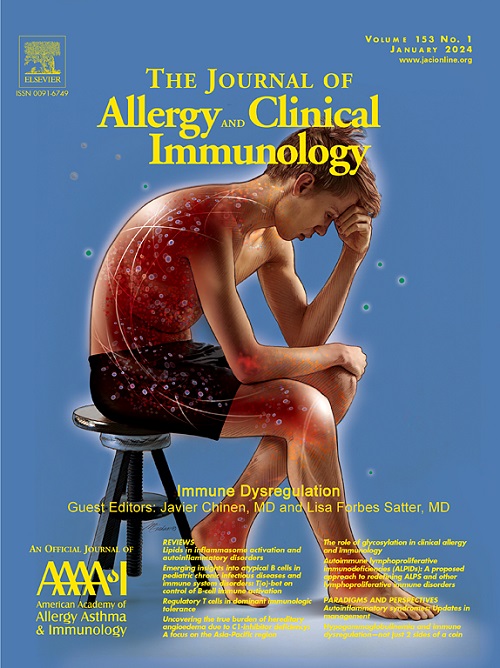Role of DOCK8 in cytokine storm syndromes
IF 11.4
1区 医学
Q1 ALLERGY
引用次数: 0
Abstract
Background
Cytokine storm syndromes (CSSs), including hemophagocytic lymphohistiocytosis (HLH), are increasingly recognized as hyperinflammatory states leading to multiorgan failure and death. Familial HLH in infancy results from homozygous genetic defects in perforin-mediated cytolysis by CD8 T lymphocytes and natural killer (NK) cells. Later-onset CSSs are often associated with heterozygous defects in familial HLH genes, but genetic etiologies for most are unknown. We identified rare dedicator of cytokinesis 8 (DOCK8) variants in patients with CSS.
Objective
We sought to explore the role of CSS patient–derived DOCK8 mutations on cytolytic activity in NK cells and to further study effects of DOCK8 deficiency in murine models of CSSs.
Methods
DOCK8 cDNAs from 2 unrelated patients with CSS with different missense mutations were introduced into human NK-92 cells by foamy virus transduction. NK-cell degranulation (CD107a), cytolytic activity against K562 target cells, and IFN-γ production were explored by flow cytometry. A third patient with CSS with DOCK8 mRNA splice acceptor site variant was explored by exon trapping. Dock8−/− mice were assessed for features of CSS (weight loss, splenomegaly, hepatic inflammation, cytopenias, and IFN-γ levels) on challenge with lymphocytic choriomeningitis virus and excess IL-18.
Results
Both patient DOCK8 missense mutations decreased cytolytic function in NK cells in a partial dominant-negative fashion in vitro. The patient DOCK8 splice variant disrupted mRNA splicing in vitro. Lymphocytic choriomeningitis virus infection promoted CSS in Dock8−/− mice and interacted with excess IL-18, limiting T-cell numbers while promoting CD8 T-cell hyperactivation.
Conclusions
Mutations in DOCK8 may contribute to CSS-like hyperinflammatory states by altering cytolytic function in a threshold model of disease.
DOCK8 在细胞因子风暴综合征中的作用
背景细胞因子风暴综合征(Cytokine storm syndromes,CSS),包括嗜血细胞淋巴组织细胞增生症(hemophagocytic lymphohistiocytosis,HLH),越来越多地被认为是导致多器官衰竭和死亡的高炎症状态。婴儿期的家族性 HLH(FHL)是由于 CD8 T 淋巴细胞和自然杀伤(NK)细胞介导的穿孔素细胞溶解的同基因缺陷造成的。晚发 CSS 常与 FHL 基因的杂合性缺陷有关,但大多数的遗传病因不明。我们在 CSS 患者中发现了罕见的 DOCK8 变异。目的 我们探讨了 CSS 患者来源的 DOCK8 变异对 NK 细胞溶解活性的作用。我们进一步研究了DOCK8缺乏对小鼠CSS模型的影响。方法通过泡沫病毒转导,将来自2名无关CSS患者、具有不同错义突变的DOCK8 cDNA导入人NK-92 NK细胞。通过流式细胞术检测了 NK 细胞脱颗粒(CD107a)、对 K562 靶细胞的细胞溶解活性以及γ干扰素(IFNγ)的产生。通过外显子诱捕法研究了第三种 CSS 患者 DOCK8 mRNA 剪接受体位点变异。在淋巴细胞性脉络膜炎病毒(LCMV)和过量 IL-18 的挑战下,评估了 Dock8-/- 小鼠的 CSS 特征(体重减轻、脾脏肿大、肝脏炎症、细胞减少和 IFNγ 水平)。患者的 DOCK8 剪接变体在体外破坏了 mRNA 剪接。LCMV感染促进了Dock8-/-小鼠的CSS,并与过量的IL-18相互作用,限制了T细胞的数量,同时促进了CD8 T细胞的过度激活。
本文章由计算机程序翻译,如有差异,请以英文原文为准。
求助全文
约1分钟内获得全文
求助全文
来源期刊
CiteScore
25.90
自引率
7.70%
发文量
1302
审稿时长
38 days
期刊介绍:
The Journal of Allergy and Clinical Immunology is a prestigious publication that features groundbreaking research in the fields of Allergy, Asthma, and Immunology. This influential journal publishes high-impact research papers that explore various topics, including asthma, food allergy, allergic rhinitis, atopic dermatitis, primary immune deficiencies, occupational and environmental allergy, and other allergic and immunologic diseases. The articles not only report on clinical trials and mechanistic studies but also provide insights into novel therapies, underlying mechanisms, and important discoveries that contribute to our understanding of these diseases. By sharing this valuable information, the journal aims to enhance the diagnosis and management of patients in the future.

 求助内容:
求助内容: 应助结果提醒方式:
应助结果提醒方式:


